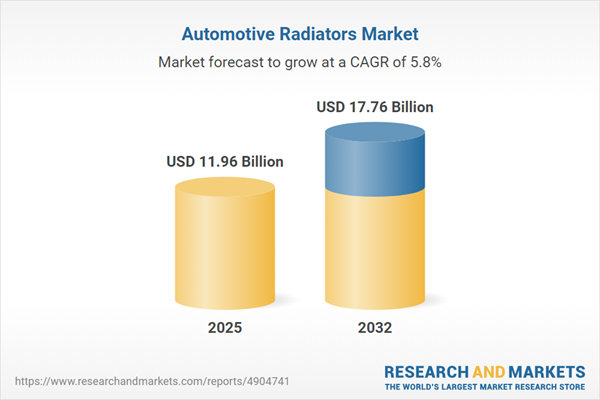Speak directly to the analyst to clarify any post sales queries you may have.
Senior leaders in the automotive radiators market face heightened complexity, shaped by rapid regulatory shifts and technological evolution. Navigating procurement, material selection, and compliance is crucial for organizations aiming to maintain a resilient and competitive edge in an increasingly dynamic global automotive landscape.
Market Snapshot: Automotive Radiators Market Overview
The global automotive radiators market is expected to grow from USD 11.29 billion in 2024 to USD 17.76 billion by 2032, delivering a compound annual growth rate (CAGR) of 5.82%. This expansion is fueled by continued investments in vehicle electrification and rising requirements for enhanced thermal management. Manufacturers and suppliers are focusing on smart, low-maintenance radiator designs that address both innovative operational standards and evolving compliance obligations. As enterprises adapt to these ongoing changes, the ability to balance procurement strategies, technological advances, and supply security becomes central to reducing risk and supporting broader business objectives.
Scope & Segmentation of the Automotive Radiators Market
- Vehicle Types: Solutions accommodate a diverse range of vehicles, including compact passenger models, sedans, SUVs, multipurpose platforms, and large-scale commercial truck fleets to address sector-specific demands.
- End Use: Radiators are engineered for distinct cooling needs across electric, gasoline, and diesel propulsion systems, supporting both established and emerging automotive portfolios as propulsion technologies progress.
- Material: Aluminum, copper-brass, and plastic composites allow procurement teams to optimize for factors such as lifecycle cost, performance durability, and sustainability targets.
- Distribution Channel: Organizations source automotive radiators through original equipment manufacturer (OEM) relationships and robust aftermarket channels, fostering flexible global and localized supply models.
- Core Type: Key design formats such as bar and plate, brazed or welded, and tube and fin architectures—covering both single and multi-pass solutions—support various operational and thermal efficiency requirements.
- Regions: Market coverage includes the Americas, Europe, the Middle East, Africa, and Asia-Pacific, each with unique regulatory, sourcing, and operational needs that influence regional procurement approaches.
- Key Industry Players: Industry leaders such as DENSO Corporation, Valeo SA, MAHLE GmbH, Marelli Holdings, Hanon Systems, Modine Manufacturing, Behr Hella Service, BorgWarner, Nissens, and Magna International drive product development and reliable worldwide supply.
Key Takeaways for Senior Decision-Makers
- Investing in innovative cooling technologies helps support the growing prevalence of electrified vehicles and addresses shifting thermal management standards.
- Switching to lightweight and composite radiator materials assists organizations in advancing sustainability initiatives and ensuring readiness for new compliance mandates.
- Incorporating ethical sourcing and a focus on recyclability into procurement enhances both regulatory compliance and supply chain stability.
- Establishing consistent lifecycle management strategies, along with simplified maintenance programs, reduces operational interruptions, particularly for multinational fleets.
- Tailoring sourcing and product development to meet distinct regional requirements ensures ongoing competitiveness, with regions like Asia-Pacific accelerating electrification and North America emphasizing commercial vehicle performance.
- Utilizing digital analytics in radiator asset tracking enables predictive maintenance, supporting improved fleet uptime and cost control.
Tariff Impact: Adjusting to Shifting U.S. Trade Policies
Shifting U.S. tariff and trade regulations require organizations to regularly review and adjust sourcing models. Many senior leaders are moving toward domestic or nearshore manufacturing, diversifying material inputs, and renegotiating supplier contracts. These actions help address cost fluctuations and fortify continuity of supply.
Methodology & Data Sources
This market research report combines direct interviews with OEM and radiator supplier executives, input from supply chain experts, and rigorous secondary analysis. Patent reviews, manufacturing benchmarks, and industry association datasets have all been utilized to ensure that insights are robust and reflect practical industry environments.
Why This Report Matters
- Enables leadership teams to benchmark new radiator technologies and establish efficient sourcing strategies that meet complex thermal management needs.
- Identifies strategic risks and growth opportunities, helping organizations proactively manage disruptions and maintain uninterrupted business operations.
- Delivers actionable advice for building agile, resilient procurement frameworks that can adapt to global regulatory and operational transformation.
Conclusion
Strategic procurement and strong supplier partnerships continue to be vital in the evolving automotive radiators market. Senior leaders who embrace data-driven planning and market adaptation remain best equipped to meet evolving compliance, sustainability, and operational requirements.
Additional Product Information:
- Purchase of this report includes 1 year online access with quarterly updates.
- This report can be updated on request. Please contact our Customer Experience team using the Ask a Question widget on our website.
Table of Contents
3. Executive Summary
4. Market Overview
7. Cumulative Impact of Artificial Intelligence 2025
Companies Mentioned
The companies profiled in this Automotive Radiators market report include:- DENSO Corporation
- Valeo SA
- MAHLE GmbH
- Marelli Holdings Co., Ltd.
- Hanon Systems Corporation
- Modine Manufacturing Company
- Behr Hella Service GmbH
- BorgWarner Inc.
- Nissens A/S
- Magna International Inc.
Table Information
| Report Attribute | Details |
|---|---|
| No. of Pages | 180 |
| Published | November 2025 |
| Forecast Period | 2025 - 2032 |
| Estimated Market Value ( USD | $ 11.96 Billion |
| Forecasted Market Value ( USD | $ 17.76 Billion |
| Compound Annual Growth Rate | 5.8% |
| Regions Covered | Global |
| No. of Companies Mentioned | 11 |









